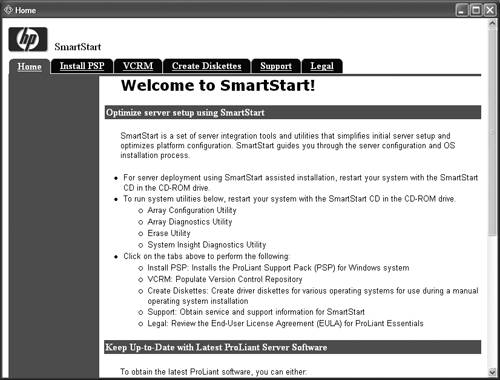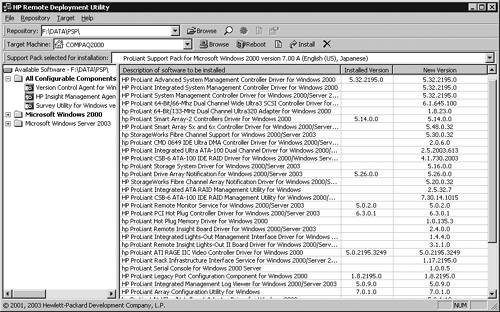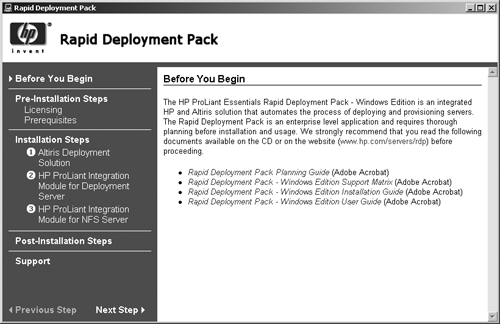Several server-deployment
methods, software-update tools, and utilities are available for ProLiant
servers; this section provides an overview of these tools.
ProLiant Essentials Foundation Pack
Formerly the ProLiant
Server Setup and Management kit, the tools are now packaged and ship as
the ProLiant Essentials Foundation Pack, which delivers one complete,
easy-to-use set of tools that ships with every ProLiant server.
The ProLiant Essentials
Foundation Pack contains the essential software needed to install,
configure, and manage ProLiant servers. It includes the Management CD,
which contains the Compaq Intelligent Manageability products, including
SIM, Management Agents; Version Control Agents; and the VCRM for
ProLiant ML, DL, and blade servers. The Foundation Pack also includes
the SmartStart CD, which contains the SmartStart server installation
application, the RDU, ProLiant Support Packs (PSP) OS support software,
and system utilities.
The ProLiant Essentials Foundation Pack includes the following:
SmartStart CD
ProLiant Support Packs (PSPs)
Support Pack Remote Deployment Utility (RDU)
System Management Homepage (Management Agents)
SmartStart Server Setup and Installation (when booted)
Firmware updates
Insight diagnostics
Array Configuration Utility
Erase Utility
Management CD
HP Systems Insight Manager (SIM)
HP SIM documentation
Version Control Repository Manager (VCRM )
Performance Management Pack (PMP) for SIM
True 64 and Open VMS Management Agents
Management Agent MIBs (Management Information Bases)
SmartStart
SmartStart assists the
server deployment process by preparing the system for installing
“off-the-shelf” versions of leading OS software. SmartStart takes
advantage of embedded ROM-based utilities that enable server and array
controller configuration. SmartStart automatically installs optimized
ProLiant server support software, known as ProLiant PSPs, with every
assisted installation. SmartStart is included in the ProLiant Essentials
Foundation Pack and ships standard with every ProLiant ML and DL 300,
500, and 700 series of servers. Figure 4 shows the SmartStart home page.

SmartStart provides the following functions:
Server setup—automated and manual
Software updates (PSP)
Firmware updates (ROM)
System diagnostics
Array diagnostics
Array configuration
Software updates and installation assistance
Optimized reliability and performance
Remote Deployment Utility (RDU)
The PSP RDU is an
application that locally or remotely deploys driver and Management Agent
updates to network attached servers. Perhaps its best feature is RDU's
capability to scan the target systems to automatically detect the needed
system updates and present the details listing the installed version
and the new version. The RDU can be operated from an IT Administrator's
workstation, where remote servers are selected for software updates.
This RDU lowers the overall cost of system software maintenance by
providing an efficient way for IT Administrators to manage deployments
of new system software updates.
The RDU is designed to work
with the PSPs. PSPs are the package and installation programs for
ProLiant server support software. PSPs represent OS-specific bundles of
ProLiant optimized drivers, utilities, and Management Agents. In
addition to the graphical RDU interface, the Remote Deployment Utility
Console is a command-line interface that allows for scripted
installation of ProLiant software components. This command-line
interface can also be used to deploy individual software components from
HP, such as the Online ROM Flash Components.
This utility simplifies
the software update process by deploying from a central software
repository. The process of deploying an update begins by selecting a PSP
for deployment. The RDU provides a convenient way to browse a network
directory or central software repository for a particular version of the
PSP. This version of the PSP, in most corporate IT environments, is one
that has been standardized on for maintaining consistent server
software configurations. The RDU interface is shown in Figure 5.

The RDU also provides a
convenient way to select a server for a deployment. Using a standard
browse feature, system Administrators can view servers on the network.
Servers can be selected for a deployment by simply clicking on the
server in the Network Neighborhood view. The RDU provides a simple,
one-step method for deploying the update after the PSP and the target
server have been selected.
The log file feature of the RDU
provides a convenient way to access the software installation history
of the server. This feature is particularly important when updating a
server at a remote site. The RDU provides a simple way for the IT
Administrator to pull up a view of the log file and review whether the
PSP installation was completed successfully. The log file is stored at
the target system and records all software installations by date and
time.
The RDU is part of HP's
strategy to deliver smart tools that simplify software maintenance
tasks, reduce complexity, and save time and resources over the life of
the server.
SmartStart Scripting Toolkit
The SmartStart Scripting
Toolkit is a server-deployment product that delivers an unattended,
automated installation for high-volume server deployments. The toolkit
facilitates scripted configuration of ProLiant servers, arrays,
Lights-Out, and OS installation with HP drivers and utilities over a LAN
or from a bootable CD. It is available for download at no cost on the
HP Web site. The toolkit is designed to support ProLiant DL, ML, and BL
series servers, as well as selected pre-ML/DL ProLiant servers and iLO,
RILOE, and RILOE II. The toolkit includes a modular set of utilities and
documentation that describes how to apply these new tools to build an
automated server-deployment process.
Using SmartStart
technology, the Scripting Toolkit provides a flexible way to create
standard server configuration scripts. These scripts are used to fully
automate many of the manual steps in the server-configuration process.
This automated server-configuration process cuts time from each server
deployed, making it possible to scale server deployments to high volumes
in rapid fashion.
Rapid Deployment Pack (RDP) Windows Edition
The RDP is an integrated
HP and Altiris server-deployment product that facilitates the
configuration, installation, deployment, and management of a high volume
of servers from a GUI-based console using either scripting or imaging
technology. The RDP software CD autostarts in the CD-ROM drive to begin
the installation, as shown in Figure 6.
With the RDP, server configuration time is reduced, making it possible
to scale server deployments to high volumes in rapid fashion.

The RDP integrates two
powerful products: the Altiris eXpress Deployment Solution and the
ProLiant Integration Module. The ProLiant Integration Module consists of
the SmartStart Scripting Toolkit, HP-supplied deployment events, and
important documentation. This deployment solution is a fast, easy,
point-and-click solution for deploying servers using imaging or
scripting and maintaining server software images, all from a management
console. The management console's GUI provides an intuitive
drag-and-drop of configurations, such as scripts and images, to deploy
the OSs and applications. Deploying a server is as easy as dragging and
dropping predefined images or scripts onto target servers with the
ability to deploy from one to hundreds of servers.
Especially designed for
the ProLiant BL servers, but supporting all ProLiant servers, the RDP
has advanced features that can detect and display server blades based on
their physical rack, enclosure, and bay location. You can set the
deployment console to automatically install or redeploy a previous
computer's configuration to a new blade when replaced.
RDP is a licensed product. A
license allows a server to be deployed and managed from the Deployment
Server Console. One license is required for each server managed from the
Deployment Server Console. An evaluation license is available on the HP
Web site.
note
RDP for
Windows is downloadable from the HP Web site. A 10-node, 7-day
evaluation license is built into every RDP. During installation, leave
the License File field blank at the Deployment Server Client Access
Point Information screen to enable the license. To obtain and use a
10-node, 30-day evaluation license, access the following URL: http://www.hp.com/servers/rdp/eval.